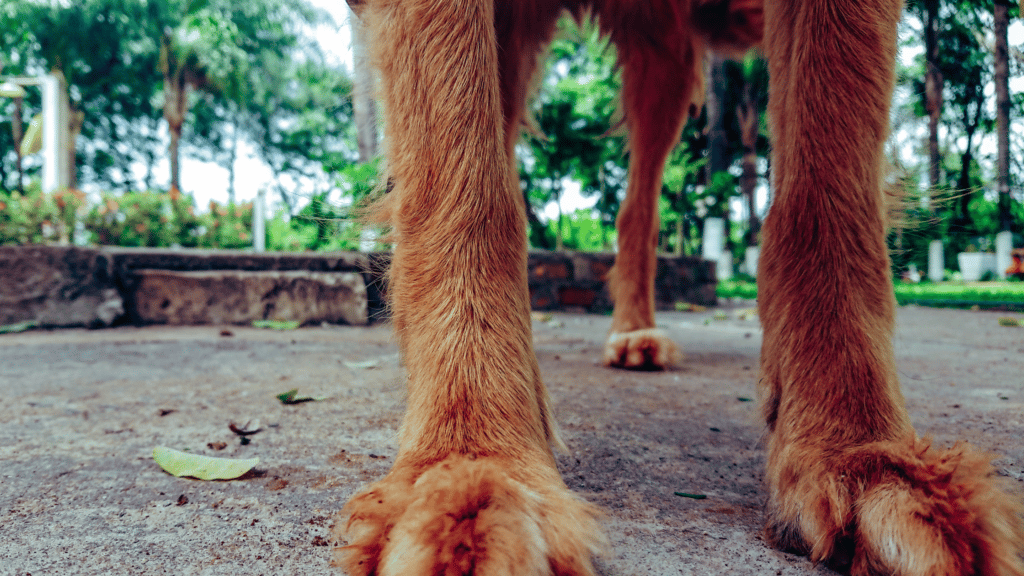Cruciate ligament injuries in dogs

The anterior cruciate ligament (ACL) is one of the most important stabilisers in the knee (also called ‘stifle’) joint and its rupture is an orthopaedic injury seen very commonly in veterinary practice. This injury is painful, and can lead to a reduction in the function of the joint and debilitating arthritis. It can greatly affect your dog’s quality of life if not treated correctly.
Types of Injury and Causes
There are two types of rupture of the canine cruciate ligament. One can occur slowly over time, and is known as a chronic or degenerative form of the disease. Most commonly, this form is caused by a combination of many factors, including ageing of the ligament (degeneration), obesity, poor physical condition, conformation and breed. In other words, the ligament injury is a result of subtle, slow degeneration that takes place over a few months or even years. The condition gradually gets worse until eventually, complete rupture of the ligament occurs.
The other form is an acute or sudden traumatic rupture of the ligament. This occurs when there is an excessive twisting of the knee joint. This can be when a dog suddenly jumps off a height such as a brick wall or after jumping out of the car.
Another common presentation is a dog with a ruptured cruciate ligament after turning quickly when leaping up to grab a ball at the park. This is very painful for dogs and they won’t be able to stand on the injured hind leg or may only ‘toe touch’ their hind leg to the ground.
Cruciate disease affects dogs of all sizes and ages. Certain breeds are known to have a higher incidence (such as Rottweiler, Staffordshire Terrier, Labrador Retriever and Mastiff), while others are less often affected (such as Greyhound, Dachshund, Basset Hound and Old English Sheepdog).
At least half of the dogs that have a cruciate ligament problem in one knee will likely, at some point in the future, develop a similar problem in the other knee.
Signs and Symptoms
As mentioned, progressive degeneration of the ACL, from very mild partial tearing to a complete tear, in the later stages of the disease is common in dogs. Because of this progression, you may not notice a severe lameness initially, especially if both knees are affected. Symptoms include:
- Not sitting ‘square’ anymore, but rather putting their leg(s) out to the side when they sit.
- Difficulty rising.
- Trouble jumping into the car.
- Decreased activity level.
- Decreased muscle mass in the affected leg (muscle atrophy).
- Decreased range of motion.
- A popping noise and swelling on the inside of the shin bone.
When a partially damaged ligament ruptures completely, your dog may also become non-weight bearing lame and may hop on three legs. Dogs in the late stages of canine cruciate ligament disease usually show symptoms associated with arthritis, such as decreased activity, stiffness, unwillingness to play and pain.
Risk Factors
Lack of fitness and obesity are risk factors for the development of canine cruciate ligament disease. Owners can play an active role in preventing the disease through regular activity and proper diet. A weight-loss program might be advisable, and can be structured to the needs of your dog by your vet.
Diagnosis of Cruciate Ligament Rupture or Tear
You should contact your veterinarian if your dog shows obvious lameness that persists for longer than a day or is in obvious pain. If your vet suspects a cruciate rupture in a dog, examination under sedation or general anaesthetic will be necessary to enable correct diagnosis.
Your vet will look for evidence of instability by feeling for any inappropriate movement of the knee joint. Your dog needs to be asleep and the joint very relaxed for a thorough evaluation. Your vet will also take x-rays to identify evidence of swelling around the joint or any arthritic changes that may indicate chronic disease.
Complications Caused by The Condition
The most common complication caused by canine cruciate ligament disease is arthritis, which can cause loss of range of motion of the joint, muscle atrophy, loss of full function of the limb and decreased activity. It is important to understand that arthritis cannot be ‘cured,’ although it can be managed effectively if treated early. This is why everything should be done to prevent its development and progression.
Treatment Options
There are many treatment options for canine cruciate ligament disease but the first major decision is between surgical treatment and non-surgical (or conservative) treatment/management. The best option for your dog depends on factors such as your dog’s activity level, size, age and conformation as well as the degree of knee instability.
Your vet will be able to give you more information on the most suitable type of treatment for your dog.